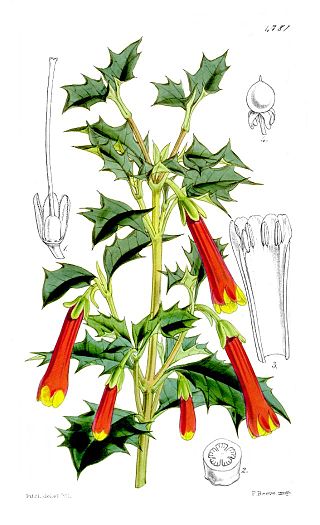Related Research Articles

The Apiales are an order of flowering plants. The families are those recognized in the APG III system. This is typical of the newer classifications, though there is some slight variation and in particular, the Torriceliaceae may also be divided.

The Araliaceae are a family of flowering plants composed of about 43 genera and around 1500 species consisting of primarily woody plants and some herbaceous plants. The morphology of Araliaceae varies widely, but it is predominantly distinguishable based on its woody habit, tropical distribution, and the presence of simple umbels.

Cussonia is a genus of plants of the family Araliaceae, which is native to the Afrotropics. It originated in Africa and has its center of distribution in South Africa and the Mascarene Islands. Due to their striking habit, they are a conspicuous and easily recognizable group of plants. Their genus name commemorates the botanist Pierre Cusson. The Afro-Malagasy and Asian Schefflera, and Afrotropical Seemannaralia genera are related taxa that share several of its morphological characteristics, among which the leaves borne on the end of branches, inflorescences carried on terminal branches or stems, and reduced leaf complexity in developing inflorescences.

Bruniales is a valid botanic name at the rank of order. Until recently it was not in use, but a 2008 study suggested that Bruniaceae and Columelliaceae are sister clades. The latest revision of the APG system, APG III, places both families as the only members of the order Bruniales, which is sister to the Apiales, and one of the asterid taxa.
References
- 1 2 Angiosperm Phylogeny Group (2009). "An update of the Angiosperm Phylogeny Group classification for the orders and families of flowering plants: APG III". Botanical Journal of the Linnean Society. 161 (2): 105–121. doi: 10.1111/j.1095-8339.2009.00996.x . Archived from the original on 25 May 2017.
- ↑ Plunkett, Gregory M.; Chandler, Gregory T.; Lowry, Porter P.; Pinney, Steven M.; Sprenkle, Taylor S. (2004). "Recent advances in understanding Apiales and a revised classification". South African Journal of Botany. 70 (3): 371–381. doi: 10.1016/s0254-6299(15)30220-9 .
- ↑ Winkworth, Richard C.; Lundberg, Johannes; Donoghue, Michael J. (2008). "Toward a resolution of Campanulid phylogeny, with special reference to the placement of Dipsacales". Taxon. 57 (1): 53–65.
- ↑ Philip D. Cantino; James A. Doyle; Sean W. Graham; Walter S. Judd; Richard G. Olmstead; Douglas E. Soltis; Pamela S. Soltis; Michael J. Donoghue (2007), "Towards a phylogenetic nomenclature of Tracheophyta" (PDF), Taxon, 56 (3): 822–846, doi:10.2307/25065865, JSTOR 25065865
- ↑ Tank, D. C.; Donoghue, M. J. (2010). "Phylogeny and Phylogenetic Nomenclature of the Campanulidae based on an Expanded Sample of Genes and Taxa". Systematic Botany. 35 (2): 425. doi:10.1600/036364410791638306.
- ↑ Doyle, J. A.; Donoghue, M. J. (1986). "Seed plant phylogeny and the origin of the angiosperms - an experimental cladistic approach". Botanical Review. 52 (4): 321–431. doi:10.1007/bf02861082.
- ↑ Butler, Rhett A. (1 July 2019). "Total number of plant species by country". Mongabay. Retrieved 21 July 2019.
- ↑ "Vegetation of South Africa". PlantZAfrica.com. SA National Biodiversity Institute. Retrieved 24 July 2019.
- 1 2 3 4 5 6 7 8 9 10 11 12 13 14 15 16 17 18 19 20 21 22 23 24 25 26 27 28 29 30 31 32 33 34 35 36 37 38 39 40 41 42 43 44 45 46 47 48 49 50 51 52 53 54 55 56 57 58 59 60 61 62 63 64 65 66 67 68 69 70 71 72 73 74 75 76 77 78 79 80 81 "species_checklist_20180710.csv". South African National Biodiversity Institute. Retrieved 27 September 2020.